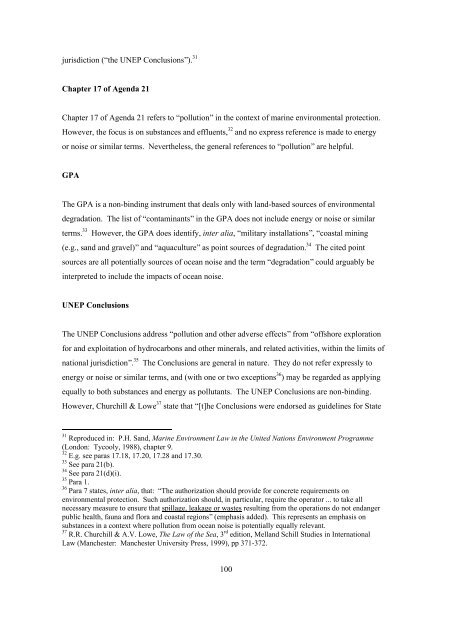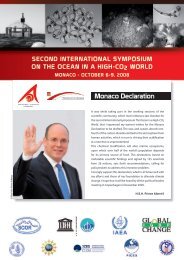Oceans of noise - Whale and Dolphin Conservation Society
Oceans of noise - Whale and Dolphin Conservation Society
Oceans of noise - Whale and Dolphin Conservation Society
- No tags were found...
Create successful ePaper yourself
Turn your PDF publications into a flip-book with our unique Google optimized e-Paper software.
jurisdiction (“the UNEP Conclusions”). 31Chapter 17 <strong>of</strong> Agenda 21Chapter 17 <strong>of</strong> Agenda 21 refers to “pollution” in the context <strong>of</strong> marine environmental protection.However, the focus is on substances <strong>and</strong> effluents, 32 <strong>and</strong> no express reference is made to energyor <strong>noise</strong> or similar terms. Nevertheless, the general references to “pollution” are helpful.GPAThe GPA is a non-binding instrument that deals only with l<strong>and</strong>-based sources <strong>of</strong> environmentaldegradation. The list <strong>of</strong> “contaminants” in the GPA does not include energy or <strong>noise</strong> or similarterms. 33 However, the GPA does identify, inter alia, “military installations”, “coastal mining(e.g., s<strong>and</strong> <strong>and</strong> gravel)” <strong>and</strong> “aquaculture” as point sources <strong>of</strong> degradation. 34 The cited pointsources are all potentially sources <strong>of</strong> ocean <strong>noise</strong> <strong>and</strong> the term “degradation” could arguably beinterpreted to include the impacts <strong>of</strong> ocean <strong>noise</strong>.UNEP ConclusionsThe UNEP Conclusions address “pollution <strong>and</strong> other adverse effects” from “<strong>of</strong>fshore explorationfor <strong>and</strong> exploitation <strong>of</strong> hydrocarbons <strong>and</strong> other minerals, <strong>and</strong> related activities, within the limits <strong>of</strong>national jurisdiction”. 35 The Conclusions are general in nature. They do not refer expressly toenergy or <strong>noise</strong> or similar terms, <strong>and</strong> (with one or two exceptions 36 ) may be regarded as applyingequally to both substances <strong>and</strong> energy as pollutants. The UNEP Conclusions are non-binding.However, Churchill & Lowe 37 state that “[t]he Conclusions were endorsed as guidelines for State31 Reproduced in: P.H. S<strong>and</strong>, Marine Environment Law in the United Nations Environment Programme(London: Tycooly, 1988), chapter 9.32 E.g. see paras 17.18, 17.20, 17.28 <strong>and</strong> 17.30.33 See para 21(b).34 See para 21(d)(i).35 Para 1.36 Para 7 states, inter alia, that: “The authorization should provide for concrete requirements onenvironmental protection. Such authorization should, in particular, require the operator ... to take allnecessary measure to ensure that spillage, leakage or wastes resulting from the operations do not endangerpublic health, fauna <strong>and</strong> flora <strong>and</strong> coastal regions” (emphasis added). This represents an emphasis onsubstances in a context where pollution from ocean <strong>noise</strong> is potentially equally relevant.37 R.R. Churchill & A.V. Lowe, The Law <strong>of</strong> the Sea, 3 rd edition, Mell<strong>and</strong> Schill Studies in InternationalLaw (Manchester: Manchester University Press, 1999), pp 371-372.100




